Recommended festivals, events, exhibitions, and autumn leaves in Shiga Prefecture in November 2014. (Most official Web sites are in Japanese only.) Compiled by Philbert Ono. Updated: Nov. 5, 2014
Video link: http://youtu.be/ve0KVtx_u74

November 3, 2014
♦ Omi Jingu Shrine Yabusame Horseback Archery, Otsu, 12:30 pm – 2:00 pm
One of Shiga’s largest shrines, Omi Jingu will hold horseback archery on this national holiday known as Culture Day. The festival starts with a ceremony at 12:30 pm in the Haiden worship hall and the archery begins at 1 pm along the main path to the shrine serving as the horse track. Expert archers from the Takeda School of Mounted Archery (from Kamakura) will perform. Reserved seating is also available for 500 yen. Call the shrine at 077-522-3725 to make reservations. Otherwise, get there early to get a good spot (standing room only). Good to see it this year since it’s the Year of the Horse. The shrine is also famous for clocks and karuta tournaments. Near Omi Jingu-mae Station on the Keihan Ishiyama-Sakamoto Line. Map | Video | Photos
近江神宮流鏑馬神事
http://oumijingu.org/publics/index/134/
November 3, 2014
♦ Little Edo Hikone Castle Festival Parade, Hikone Castle, 1:00 pm – 3:00 pm
Very elaborate costume parade of mainly kids dressed as samurai and Edo-Period ladies. Highlights include the Hikone Gun Battalion giving a matchlock gun demo (in front of Horse Stable), Ii Naosuke played by an actor on horseback, fireman acrobatics, and Sarugaku dancers. The parade route starts from Joto Elementary School and proceeds along the road to the castle and passes in front of the Umaya Horse Stable. Video here. Short walk from JR Hikone Station. Map | Video | Photos
小江戸彦根の城まつりパレード
http://www.hikoneshi.com/jp/event/articles/c/parade
Until November 9, 2014 (closed Thursdays)
♦ BIWAKO Biennale 2014, Omi-Hachiman, 10:00 am – 5:00 pm
Held for the 6th time, the BIWAKO Biennale showcases the work of about 60 artists in Omi-Hachiman’s traditional townscape area. Art exhibitions will be in former merchant homes, traditional houses, and a sake factory. A blend of modern art and traditional Japanese buildings. Workshops for kids by the artists, and concerts in various places. Advance tickets ¥1,800 (available at Lawson) or ¥2,000 at the door.
BIWAKOビエンナーレ
http://energyfield.org/biwakobiennale/page/english
Until November 9, 2014 (closed Oct. 20 and 27)
♦ Yellow catfish exhibit at Lake Biwa Museum, Kusatsu, 9:30 am – 5:00 pm
Live display of a rare yellow catfish endemic to Lake Biwa is at the museum’s aquarium. It is a medium-size species called Iwatoko-namazu (イワトコナマズ Silurus lithophilus) in Japanese. It is not the large Lake Biwa Giant Catfish which can also be yellow. This species normally live in rocky waters in northern Lake Biwa. Map
http://www.lbm.go.jp/english/
http://www.lbm.go.jp/tenji/suizoku/topic/index.html
November 8-9, 2014
♦ Shiga-Biwako Brand Fair, JR Osaka Station (Osaka Station City 1st floor), 11:00 am – 6:00 pm
This event is not in Shiga, but in Osaka. It’s a Shiga products fair where you can taste and buy stuff from Shiga. There will also be stage entertainment such as mascots from Shiga. Hiko-nyan is scheduled to appear on Nov. 8 at 11:30 am and 2 pm. Crafts people will also demonstrate the making of Omi-jofu hemp cloth and Hikone Buddhist altars.
http://www.motherlake.jp/wordpress/wp-content/uploads/2014/11/burand-tirashi.pdf
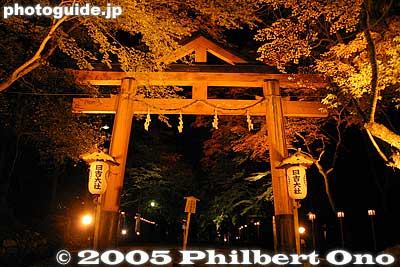
November 15-30, 2014
♦ Hiyoshi Taisha Shrine Maple Festival Light-up, Otsu
Hiyoshi Taisha Shrine at the foot of Mt. Hie in Otsu, Shiga Prefecture is the head shrine for all Hiyoshi, Hie, and Sanno Shrines in Japan (around 2,000). The spacious grounds includes two shrines that are National Treasures and 3,000 maple trees lit up at night 5:00 pm – 8:30 pm during this period. Even the green leaves look great against the dark sky. Highly recommended if you’re in that part of the city. Near Hiezan Sakamoto Station on the JR Kosei Line and Keihan Line’s Sakamoto Station. Map | Photos
もみじ祭
http://hiyoshitaisha.jp/event/momiji/
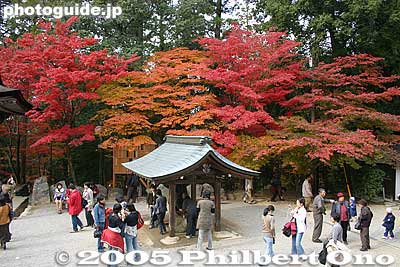
November 22-30, 2014
♦ Koto Sanzan Temple Trio autumn foliage, Kora, Aisho, and Higashi-Omi
Koto Sanzan (湖東三山) is a trio of large Tendai Buddhist temples in eastern Shiga: Saimyoji (西明寺) in Kora, Kongorinji (金剛輪寺) in Aisho, and Hyakusaiji (百済寺) in Higashi-Omi. They are famous for autumn leaves and structures that are National Treasures or Important Cultural Properties. Each temple also has its own unique characteristics. Saimyoji has a National Treasure Hondo worship hall and National Treasure pagoda that you can enter. It’s also deservedly one of Japan’s 100 Grand Autumn Foliage Sites. Kongorinji has many little Jizo statues and a National Treasure Hondo main hall housing an 11-faced Kannon statue and 13 other statues that are Important Cultural Properties. It is also displaying Japan’s oldest Daikokuten statue until Nov. 30, normally hidden from view. It’s 1,200 years old. Hyakusaiji is famous for giant straw sandals on a gate and a Japanese garden. Established by Shotoku Taishi in 609, Hyakusaiji is Shiga Prefecture’s oldest temple and one of Japan’s oldest. The Hondo temple hall has an 11-faced Kannon statue carved by Shotoku Taishi, a prince credited with spreading Buddhism in Japan.
During this period, convenient shuttle buses (Koto Sanzan Shuttle Bus) run every day between these three temples and a few train stations. The shuttle buses run most frequently from north to south, that is, from Saimyoji to Kongorinji and then to Hyakusaiji. If you start from the north, board the shuttle bus at Hikone Station. The bus will take you to Taga Town Hall from which you transfer to a bus bound for Saimyoji first.
From the south, board the bus at Ohmi Railways Yokaichi Station. The bus will stop at Hyakusaiji first. (A different bus also goes to Eigenji.) Check the bus stop for bus departure times. After touring Saimyoji (or Hyakusaiji), catch another shuttle bus to the next temple. Shuttle buses also run from Hyakusaiji to Eigenji (listed below), another temple famous for foliage. From Saimyoji, the last shuttle bus leaves at 5:23 pm for Taga Town Hall where you can catch a bus to Hikone Station (or walk to Taga Taisha-mae Station).
From Hyakusaiji and Eigenji, buses go to Ohmi Railways Yokaichi Station. From Hyakusaiji, the last shuttle bus leaves at 4:30 pm for Ohmi Railways Yokaichi Station arriving at 5 pm. Note that from this year, shuttle buses will not run from Amago Station and Kawase Station.
Bus fare is 200 yen per ride which is only 10-20 min. They also offer a day pass called Momiji kippu (Maple ticket) for 1,800 yen. This day pass includes passage on all Koto Sanzan shuttle buses and all Ohmi Railways trains. A good deal if you plan to ride on Ohmi Railways. Each temple also charges admission of 500 yen. Note that if you like to take your time, you might not be able to see all three temples in one day.
Saimyoji Map | Kongorinji Map | Hyakusaiji Map
秋の湖東三山
http://www.ohmitetudo.co.jp/bus/7859/index.html/
http://www.ohmitetudo.co.jp/file/2014syatoru_mbddzcwliqsfvpkoptqcjawmnaaowxfb.pdf
Official sites: Saimyoji | Kongorinji | Hyakusaiji

November 8-29, 2014
♦ Eigenji Temple Autumn Foliage and Light-up, Higashi-Omi, 5:00 pm – 8:30 pm for light-up
Although this temple is not one of the Koto Sanzan Temple Trio, it’s also famous for autumn leaves with 3,000 maple trees. Along with Saimyoji, Eigenji is also one of Japan’s 100 Grand Autumn Foliage Sites. Established in 1361, Eigenji belongs to the Zen Rinzai Buddhist Sect (Eigenji School). Since it’s a different sect, Eigenji is not a member of the Koto Sanzan trio of Tendai Sect temples. Impressive during the day, but also beautiful at night when the leaves are illuminated along with the walking paths. Admission 500 yen.
From Ohmi Railways Yokaichi Station, go to Bus stop 1 and take the bus going to Eigenji Shako (永源寺車庫) and get off at Eigenji-mae (永源寺前). Takes about 35 min. Bus schedule from Yokaichi Station on weekdays | Saturday | Sunday. Note that from Eigenji-mae, the last bus for Yokaichi Station leaves at 7:26 pm on Sat./Sun. and 8:27 pm on weekdays. Shuttle buses from Hyakusaiji also run to Eigenji during Nov. 16-Dec. 1. Map
永源寺 ライトアップ
http://eigenji-t.jp
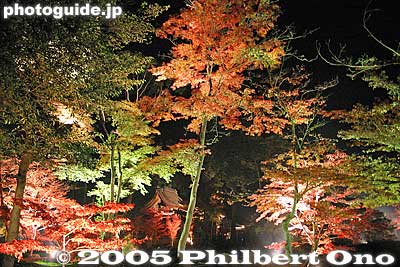
November 14-30, 2014
♦ Hyozu Taisha Shrine Garden Autumn Foliage Light-up, Yasu, 5:45 pm – 9:00 pm (enter by 8:30 pm)
Established in 717 (Nara Period), Hyozu Taisha Shrine has a noted Japanese garden with a pond ringed by small rolling hills and autumn leaves. The fall leaves certainly look colorful and impressive when illuminated in the evenings and reflected in the pond. Mini concerts will be held during the foliage illumination in the evenings.
A short bus ride from JR Yasu Station’s North Exit (Kita-guchi). Take the Yoshikawa Line (going to Nishi Kawahara 2-chome 西河原2丁目 or Ayame-hama あやめ浜) and get off at Hyozu Taisha 兵主大社. Buses are infrequent (schedule here). The last bus leaving Hyozu Taisha for Yasu Station leaves around 9:02 pm on weekdays and around 7:17 pm on Sat./Sun. Or take a taxi (costing about 2,000 yen from Yasu Station). Map
兵主大社庭園紅葉ライトアップ
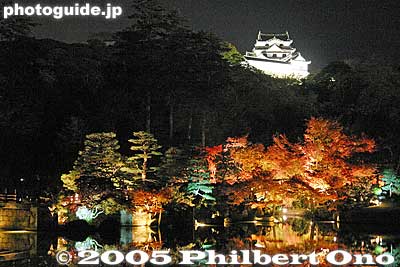
November 14-December 7, 2014
♦ Genkyuen Garden Autumn Foliage Light-up, Hikone, 6:00 pm – 9:00 pm (enter by 8:30 pm)
Adjacent to Hikone Castle, Genkyuen was built as a castle garden in 1677 by Ii Naooki, the fourth lord of Hikone Castle. I would call this Shiga’s best place to view autumn foliage illumination. The pond’s reflection of the colorful autumn leaves at night doubles the impact. Hikone Castle in the background is also lit up for a perfect night scene. Reminds me of a master painter using a black canvas. Admission 500 yen. Short walk from JR Hikone Station. Map
錦秋の玄宮園ライトアップ
http://www.hikoneshi.com/jp/event/articles/c/
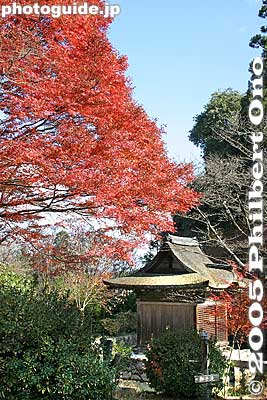
November 15-30, 2014
♦ Konan Sanzan Temple Trio Autumn Tour, Konan, all day
Not to be confused with Koto Sanzan, Konan Sanzan is a trio of Tendai Buddhist temples in the city of Konan. A small city like Konan is lucky to have as many as four National-Treasure structures at the three Konan Sanzan temples. Like Koto Sanzan, Konan Sanzan temples are also noted for autumn leaves. During this period, a convenient shuttle bus plies between the temples and train stations.
The temples are Jorakuji 常楽寺, Chojuji 長寿寺, and Zensuiji 善水時. Jorakuji has not one, but two buildings that are National Treasures: the Hondo main hall and three-story pagoda. Chojuji means, “Long Life Temple,” and its small, but distinctive Hondo hall is a National Treasure. Zensuiji has the largest and most impressive Hondo hall (National Treasure) bearing elegant roof lines. Not to be missed by architectural buffs. The three temples are all in quiet, rural neighborhoods.
One thing you have to understand is that two of the temples (Jorakuji and Chojuji) are on one side of the train tracks and the third temple (Zensuiji) is farther away on the other side of the tracks. So there are two separate bus routes going to the three temples and there’s a train ride between Jorakuji/Chojuji and Zensuiji.
The Konan Community bus called Meguri-kun runs from JR Ishibe Station (JR Kusatsu Line) to Jorakuji and Chojuji once an hour from 8:24 am to 3:45 pm. From Jorakuji, you can take the bus to Chojuji. From Chojuji, take the bus back to JR Ishibe Station and catch the train to JR Kosei Station one stop away. From JR Kosei Station, take the bus to Zensuiji. The last bus leaves Zensuiji at 5:17 pm for JR Kosei Station. You can also tour the temples in reverse order, starting with Zensuiji. In the morning, buses leave JR Kosei Station (north exit kita-guchi) for Zensuiji at 8:28 am, 9:20 am, 9:30 am, 10:15 am, and 11:25 am. Bus schedule here. Map
湖南三山めぐり
http://www.burari-konan.jp/konan3zan/
November 15-December 7, 2014
♦ Kyorinbo Garden Autumn Foliage Light-up, Azuchi, Omi-Hachiman, 5:00 pm – 8:00 pm (enter by 7:30 pm)
Beautiful Japanese garden designed by Kobori Enshu. Part of a temple at the foot of Mt. Kinugasa. Autumn foliage at night is reputed to be most beautiful. Of course, you can also go during the day. Tripods/monopods not allowed. The garden is usually open only on weekends and holidays, but it will be open every day during Nov. 1 to Dec. 15. Admission 500 yen. From JR Azuchi Station, take a taxi for 10-min. ride. Google Map
石の寺 教林坊 紅葉ライトアップ
http://www.d1.dion.ne.jp/~marche/kyourinbou/
November 29-30, 2014
♦ Hot Air Balloon Over Lake Biwa, Takashima, early morning
Dramatic sight of hot-air balloons crossing Lake Biwa. They start off very early in the morning so you would have stay near the launching beach in Takashima. Note that weather conditions can cancel the event.
熱気球琵琶湖横断
http://www.takashima-kanko.jp/new/20141010_1704.html
November 30, 2013
♦ Tonda Ningyo Bunraku Puppet Show, Lute Plaza, Nagahama, 1:30 pm
The famous Tonda Ningyo Bunraku puppet troupe will perform three acts. Admission 1,200 yen at the door.
At JR Nagahama Station, go to Bus stop 1 and take the bus at 12:27 pm going to Nagahama Shiyakusho Azai-shisho-mae (長浜市役所浅井支所前) and get off at Biwa Shisho-mae (びわ支所前). Takes about 20 min. Only three buses go there on Sunday. Or take a taxi if you’re rich or going with friends. Google Map
人形浄瑠璃「冨田人形」
http://www.city.nagahama.shiga.jp/events/index.cfm/detail.1.37576.html
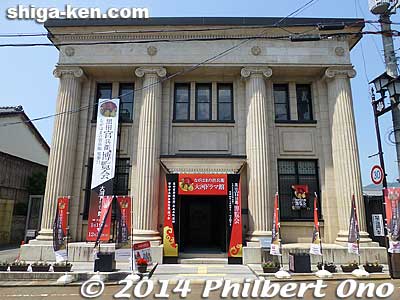
Until Dec. 28, 2014
♦ Kuroda Kanbe’e Expo, Nagahama, 9:00 am – 5:00 pm
Yet another “expo” (an overkill name) based on another year-long NHK Taiga Drama. This is the third such expo held in Nagahama in recent years. The drama this time is Gunshi Kanbei airing on NHK-G on Sunday evenings until Dec. 2014. The subject is Kuroda Kanbe’e (also called Kanbei and Yoshitaka), a samurai daimyo and brilliant military strategist for warlord Toyotomi Hideyoshi during the 16th century. Although he was from Himeji, the Kuroda clan supposedly came from Omi (Shiga). This thin connection prompted Nagahama to hold year-long, small-scale exhibitions in Kinomoto and central Nagahama.
The main exhibition is in Kinomoto. It’s in a western-style, former bank building called Sengoku Taiga Kinomoto-kan (戦国大河きのもと館). A short walk from JR Kinomoto Station. The building, nicknamed Drama-kan, has exhibits introducing the characters in the Taiga Drama. No English captions. The display layout is very similar to the last expo held there in 2012. Admission is 300 yen for adults, free for kids. Open every day. Map
Also, a 10-min. walk from Kinomoto Station is the Kuroda Clan gravesite (黒田家御廟所) for six generations of the Kuroda Clan who lived in this area for 200 years. Nearby is a resthouse. Free admission. Map
The second exhibition venue is Nagahama Castle near JR Nagahama Station. Called Rekishi-kan, it mainly explains the historical background, slanted toward Toyotomi Hideyoshi. Admission is 400 yen, and 200 yen for elementary and jr. high kids (free for infants). Open every day. Map
If you plan to visit the venues in both Kinomoto and Nagahama, it is cheaper to buy the “set ticket” costing 500 yen. Expo tickets are sold at all the venues. The “set ticket” includes a bus tour called the Oku-Biwako Omotenashi Bus leaving Kinomoto Station and Takatsuki Station on weekends. It tours northern Nagahama to the Drama-kan in Kinomoto, the Kuroda Clan gravesite, and a few Kannon temples and museum in Takatsuki. Bus departure times are on the pamphlet here (in Japanese).
A minor venue is the Nagahama Hikiyama Museum. It just has a few panel displays about Kuroda and the Taiga Drama. It’s in the lobby area and free. Pay the admission if you want to see Hikiyama Matsuri floats. Map
http://kitabiwako.jp/kanbee/
December 1, 2014
♦ Tarobogu Shrine Fire Festival, Higashi-Omi, Noon – 4:00 pm
Held annually on the first Sunday of December, the Tarobo Shrine Fire Festival burns a big pile of 100,000 wooden prayer tablets called goma (護摩) collected from believers all over Japan. The tablet is written with the believer’s name, address, and prayer wish. The fire burns as a prayer for family health and safety. After the fire settles down, barefoot priests walk over the hot ashes. Very dramatic festival (photo here).
Short walk from Ohmi Railways Tarobogu-mae Station. Map
太郎坊宮お火焚大祭
http://www1.ocn.ne.jp/~tarobo/
For art and museum exhibitions in Shiga, see Kansai Art Beat’s exhibition schedule for Shiga museums.





